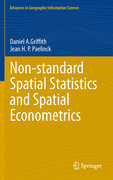
Non-standard spatial statistics and spatial econometrics
Griffith, Daniel A.
Paelinck, Jean H. Paul
Despite spatial statistics and spatial econometrics both being recent sproutsof the general tree 'spatial analysis with measurement'—some may remember thedebate after WWII about 'theory without measurement' versus 'measurement without theory'—several general themes have emerged in the pertaining literature. But exploring selected other fields of possible interest is tantalizing, and this is what the authors intend to report here, hoping that they will suscitateinterest in the methodologies exposed and possible further applications of these methodologies. The authors hope that reactions about their publication will ensue, and they would be grateful to reader(s) motivated by some of the research efforts exposed hereafter letting them know about these experiences. ARS paper is presented in its unabridged version Previously unpublished spatial statistics and spatial econometrics work is presented An historical background for this work is summarized INDICE: Part 1. Non-standard spatial statistics.- 1. Introduction: spatialstatistics, - 2. Individual versus ecological analyses.- 3. Statistical models for spatial data: some linkages and communalities.- 4. Frequency distributions for simulated spatially autorcorrelated random variable.- 5. Understanding correlations among spatial random variables.- 6. Spatially structured random effects: a comparison of three popular specifications.- 7. Spatial filter versus conventional spatial model specifications: some comparisons.- 8. The role ofspatial of autocorrelation in prioritizing sites within a geographic landscape.- 9. General spatial statistics conclusions.- 10. References: spatial statistics (Part 1) Part 2. Non-standard spatial econometrics.- 11. Introduction: spatial econometrics.- 12. Mixed linear-logarithmetic specification for Lotka-Volterra models with endogenously generated SDLS-variables.- 13. Selecting spatial regimes by threshold analysis.- 14. Finite automata.- 15 Learning from residuals.- 16. Verhulst and Poisson distributions.- 17. QUARLIREG: qualitative regression and its application to spatial data.- 18. Filtering complexity for observational errors and spatial bias.- 19. General spatial econometrics conclusions.- 20. References: spatial econometrics (Part 2).
- ISBN: 978-3-642-16042-4
- Editorial: Springer
- Encuadernacion: Cartoné
- Páginas: 200
- Fecha Publicación: 15/12/2010
- Nº Volúmenes: 1
- Idioma: Inglés
